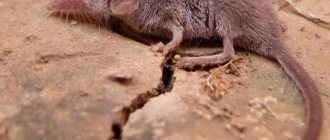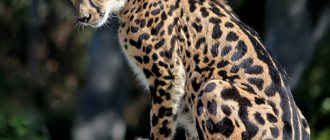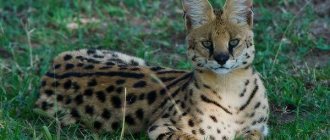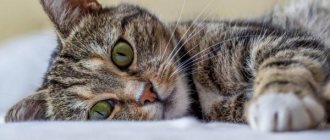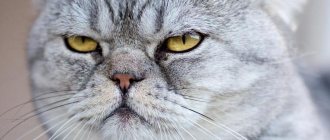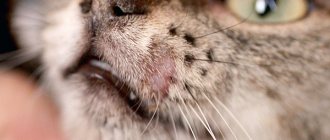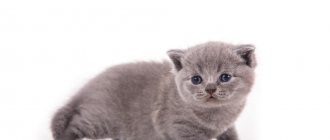History of origin
In 1961, Bengal domestic cats appeared in the United States. This happened at the moment when D. Sugden, a geneticist, brought a small wild leopard cat kitten from Bangkok.
Leopard cat in the wild
The kitten turned out to be a female, she was named Malaysia. Having matured, the cat gave birth to a kitten from the owner's black cat. As a result, a cat was born that looked like its mother. The animal was in excellent health. Despite the fact that she gave birth to two kittens, all of them were not destined to survive, and work on breeding was stopped. As a result of the failures, Jean decided to give Malaysia to the local zoo.
Despite the current situation, Jean did not give up her dream of breeding cats of this amazing color. She resumed her experiments in 1980. At that time, work was being done on crossing wild leopard cats with domestic ones at the University of California. Jean became interested in this study and was able to collect 9 hybrid females not participating in the experiment.
In 1982, Jean, while traveling in India, bought a wild kitten with an amazing golden-orange spotted color. It turned out to be a male who became an excellent father of wonderful offspring. After this, leopard cats began to multiply rapidly.
For your information! The breed first received official recognition in 1991. This happened after participating in the TICA championship.
Asian leopard cat
This wild feline can be found as a pet. It was this species that was directly involved in the development of the popular and well-known breed today.
The animal lives in the wild on the plains of Asia, as well as in its forests. In Russia, this species can be found in the Ussuri taiga. Externally, wild leopard-colored cats are practically no different from domestic cats. The only difference is the long limbs of the inhabitants of the taiga.
Not a single animal in the world is capable of catching up with a cheetah at a short distance. One experiment showed that this beast is capable of accelerating to 84 km/h in 4 seconds, like a racing car. His speed record is about 110 km/h.
Of course, you have to pay for such a gift - because such stress does not pass without a trace. There are times when a cheetah, having run several hundred meters at great speed, simply loses consciousness and then takes a very long time to come to its senses. Therefore, the cheetah has developed its own special hunting style.
[advert]
First, he looks out for prey, lying in dense thickets or on the top of a small hill. Having identified the victim, it slowly and silently tries to crawl as close to it as possible. When there are several tens of meters left to the target, the cheetah takes off with a swift jerk and rushes towards the prey with furious acceleration.
If he catches up, he knocks him down with a powerful blow from his front paws and instantly gnaws his throat. If it doesn’t catch up in the first seconds, it never pursues the escaping game, but again freezes in the shelter, waiting in the wings.
Cheetahs are diurnal predators. They hunt mainly small ungulates: gazelles, impalas, wildebeest calves, as well as hares. Three cheetahs can defeat an ostrich. 87% of a cheetah's prey is Thomson's gazelle. Cheetahs usually hunt early in the morning or in the evening, when it is not very hot, but there is enough light. They navigate more by sight than by smell.
The cheetah eats almost as fast as it runs. He mainly eats entrails and drinks blood - this food helps him quickly regain his strength. This accelerated feeding is explained by the fact that the cheetah is unable to carry away large prey with itself and cannot protect it from stronger predators - lions - or from more arrogant and numerous - hyenas. Unlike the latter, the cheetah is surprisingly clean, prefers fresh game and will never eat carrion.
The cheetah is a completely unique animal. Scientists classify it as a member of the cat family, but in structure the cheetah is more reminiscent of a hound dog. Compared to the body, the legs are very long, thin, slender and at the same time strong.
The cheetah is completely covered with short fur and has a small mane on its head. He can purr like a house cat, but he grabs his prey by the throat in a completely dog-like manner and, in addition, is capable of yelping just like a real dog.
The cheetah's claws are retracted into the pads only in cubs, and with age they remain outside forever, which also makes it similar to the dog. The color of this animal is yellowish, sandy, and small dark solid spots are densely scattered throughout the entire skin, except for the belly. Near the eyes, the cheetah wears two black stripes, similar to streaks of tears, which gives the animal a sad appearance.
There is a legend about the origin of these stripes: when God created the cheetah, it began to treat other animals with anger and arrogance. For this, the predator received a reprimand from the Almighty and cried black tears, which left a mark on his face reminiscent of God's wrath.
In fact, the cheetah is a very peace-loving and affectionate animal, it is easily tamed, and there has not yet been a recorded case of a cheetah attacking a person.
Interesting Facts
On June 20, 2012, an eleven-year-old female cheetah named Sarah set a new world record in the 100-meter race among animals in the United States, running this distance in 5.95 seconds. The race took place at the zoo in the American city of Cincinnati.
These animals are mentioned in the “Tale of Igor’s Campaign”: “On the river on Kayal, darkness covered the light - the Polovtsy spread across the Russian land, like a brood of cheetahs.”
The cheetah's great natural hunting abilities and peaceful disposition prompted residents of many countries to use it as a hunting animal.
The first information about the use of cheetahs for hunting dates back to 1580-1345 BC. In ancient Thebes, images of two cheetahs kept on leashes were found. Centuries ago, cheetahs were hunted in many Asian countries. Hunting with cheetahs was especially grandiose in India, where it became most widespread in the 16th century and at the beginning of the 17th century.
The scale of the hunt can be judged by the fact that Khan Akbar during his reign kept up to 1000 cheetahs at a time - they were caught with loops of antelope tendons placed near the trees on which the animals came to sharpen their claws.
Training a hunting cheetah was relatively easy. In the first days after the capture of the animal, they kept him without food for some time and prevented him from sleeping. Then the hungry, severely weakened predator was taught to take food from the hands of the person caring for it, giving it food and water. Later, the tamed animal began to be taken out on four stretching leashes to the most crowded streets and bazaars.
When the cheetah got used to its owner, it was accustomed to horses and dogs. After this, the animal was baited with the game that they were going to hunt with it. And only after six months of training it was possible to start hunting small antelopes and hares.
There were different ways of hunting with hunting cheetahs. Here is one of them, used in India and China: the predator was placed on a special two-wheeled cart that had a springboard at the back. The cheetah was tied to the cart with a leash, the free end of which was attached to the belt worn by the animal. Zebu or bulls of other local breeds were harnessed to the cart.
This method is designed to ensure that antelopes get used to the sight of peasant carts and therefore often allow them to come within a relatively close distance. To prevent the cheetah from being distracted or worried while approaching the game, its eyes were covered with a special bandage. Hunters, having noticed a herd of antelope, began to ride around them until the radius was reduced to 100-300 m.
Having approached such a distance, the cheetah was untied, the blindfold was removed from its eyes and the game was shown to it. Having caught up with the antelope, the animal knocked it to the ground with blows of its paws and began to choke it. At this time, a hunter ran up to him, cut the throat of the prey and, having collected blood in a special ladle, offered it to the cheetah. After feeding the cheetah with blood, the bandage was put on him again and he was taken to the cart.
The king cheetah is a rare mutation that differs from the normal cheetah in coloring. This coloration is caused by a recessive gene that must be inherited from both parents, which is why king cheetahs are so rare.
In Europe, the cheetah has also been known for a long time. The first mention of hunting with cheetahs dates back to 439, when two hunting cheetahs were brought from India as a gift to Emperor Anastasius of Constantinople. A message has been preserved that in 1100, when the Lombard crusaders approached Constantinople, the Greeks released lions and cheetahs kept in the palace on them, and the latter did not attack the attackers.
Byzantine miniatures of the 12th-13th centuries often depicted hunting with cheetahs. European feudal lords kept cheetahs for hunting and set up “leoparderies” - special premises where predatory animals were kept.
Hunting cheetah. Ancient Egyptian image, 1700 BC.
In France, people hunted with cheetahs already in the 11th century. During the Renaissance in this country, cheetahs were so common on the estates of lords that they were mentioned in most literary works of the time and were often depicted in tapestries.
Several of these tapestries with cheetahs woven on them are kept in the Hermitage.
There are many historical accounts of hunting with cheetahs in Italy. Thus, Frederick II, Holy Roman Emperor (1220-1250), had a leoparderia in the castle of Lucera in Apulia.
The cheetahs were brought to him from North Africa. The French king Louis XII hunted hares and roe deer with cheetahs in the Amboise forest.
This hobby did not bypass Ancient Rus' either. In our country, the cheetah was called “pardus”, and the people involved in their training were called “pardusniks”. In Russian chronicles and legends, pardus is mentioned more than once. In the margins of Svyatoslav's Collection, which dates back to 1073, two cheetahs with collars are depicted hunting hares. This ancient monument is kept in the Historical Museum in Moscow.
The last hunt involving cheetahs took place in India in 1942.
Now hunting with a cheetah is out of the question - the number of these animals in the world has greatly decreased. The predator was last seen in Saudi Arabia in 1950, and the last cheetah in India was killed in 1955.
More recently, it still lived on the territory of Turkmenistan, but by now it seems that it has also disappeared. Of the entire vast range in Asia, a small area remains in Iran (Khorasan). True, there are unverified reports that Iranian cheetahs appear in Turkmenistan and Uzbekistan (Yu. Myslin).
In Africa, the cheetah has survived only in remote places or in protected areas. Unfortunately, today this amazing animal is facing complete extinction.
Other types of breeds with leopard coloring
Striped and spotted colors in animals are determined by the presence of a special T gene. Depending on the type of breed, the main color may be darker or lighter than the spots.
Savannah domestic cat
Today, the most popular types of cat breeds with leopard coloring are the following:
- The Bengal is a hybrid breed that is the result of crossing a domestic cat with a leopard cat. Currently, representatives of this species are very popular and are in great demand;
- savannah. The name of the breed was registered in 2001. The individuals were obtained by crossing the Serval and the Abyssinian breed. Representatives of the breed are considered one of the most expensive and largest;
- Serengeti. The species was created in 1994 as a result of crossing the Bengal and the Oriental. Such cats are distinguished by the fact that they are able to make various sounds that are not characteristic of ordinary cats;
- Ussuri. The species was registered in 1994. Outwardly similar to a wild cat;
- chito. Brought out by crossing an Ocicat and a Bengal cat. Representatives of the breed are distinguished by an easy-going character and are strongly attached to people. The coat can be of 6 colors, it is very thick and velvety.
This is not the entire list of cats with leopard color. It would take a very long time to list them.
General characteristics and description
The leopard cat is an amazing and striking representative of the cat family in its color. It stands out for its graceful appearance and luxurious spotted skin. Currently, there are about a dozen different subspecies. Individuals differ from each other in color and size of spots.
Note! The tip of the tail of leopard representatives of the species is always black.
Breed standard
The leopard cat is distinguished by its well-developed muscles and very large size. Males grow up to 80 cm in length, and females are slightly smaller, from 50 cm. They weigh from 3 to 8 kg, depending on gender. The tail of this species is about 30 cm long, massive, cone-shaped with a rounded tip.
The Asian leopard cat has a relatively small head with smooth, streamlined, wedge-shaped lines. The frontal part is not wide. The muzzle is extended from the ears to the mouth. The ears are medium in size, protruding forward with rounded tips. The eyes are wide-set and oval with a black border. The hind legs are slightly longer than the front legs.
Color
The leopard-like cat can be spotted or marbled in color. The spots stand out brightly against the main background. They can be black or brown. The main color of representatives of this species is gray or red.
For your information! A purebred animal always has bright and clear pigmentation, which resembles the fur of a leopard.
Distribution and lifestyle of the cheetah
The cheetah lives in lowland deserts and savannas. It is found in southwestern and eastern Africa, India and Asia. The cheetah is a small species and is rarely found throughout its habitat.
The cheetah, unlike many cats, is diurnal. He hunts during the day or at dusk, sometimes at night. Before the hunt, the cheetah rests in its den, in the grass or in the shade of a bush. The cheetah has very sharp eyesight. He notices his prey from afar and sneaks up on it, using uneven terrain at a distance of 151 to 200 meters. Then a swift and fast (up to 500 meters) chase begins. When running, a cheetah pushes off with its hind and front paws simultaneously. This allows the cheetah to reach speeds of over 100 km/h (read more: cheetah speed). The cheetah's body is optimized for perfect cutting through the air. At tremendous speed, the cheetah is capable of jumping over a distance of up to six meters. With its long paw, the predator delivers such a blow with such force that its prey flies somersaults. If the cheetah misses, it does not continue the chase. The cheetah is not capable of long running; it is easier for him to start the hunt all over again than to engage in prolonged pursuit. Often these animals hunt in pairs or even in large families, which is not typical for cats; only lions live in prides. Cheetahs hunt gazelles, gazelles, and small antelopes. It also feeds on birds and hares. Most often, these animals stay alone, except when raising young animals.
Cheetahs in northwest Africa.
Character and behavior: advantages and disadvantages
In the wild, leopard cats are unsociable and prefer to lead a solitary lifestyle. Their communication is limited only to representatives of their own kind, and this only happens during the breeding season. They show aggression extremely rarely, and when meeting animals and people they are a little timid and try to hide in cover as quickly as possible.
Colors of Bengal cats
Spotted animals behave desperately and aggressively when their cubs are in danger. In such a situation, they make specific sounds and also actively use their teeth and claws. It is recommended to tame kittens of this species from an early age.
In the wild, they prefer to be nocturnal and spend their days in their den. Representatives of this species can perfectly climb trees, swim and jump on rocks. The territory is marked with urine. In the wild, the lifespan of leopard cats varies from 12 to 15 years.
In captivity, a leopard cat gets along well with its relatives, other cats and even dogs.
For your information! Leopard cats have very low stress tolerance. They should be handled with extreme caution; there have been cases where representatives of this species even died from stress.
The process of domesticating a leopard cat as an adult is impossible. At the same time, small kittens, even those born in the wild, can become loyal and calm animals. A violent character can only appear when they reach puberty, so it is recommended to castrate cats.
A little about baby cheetahs...
These touching creatures are born monochromatic, with a tassel on their tails, which helps their mother find playful babies among the plants. Kittens have a luxuriant mane covering most of their body. All these insignia disappear by three months.
Newborn babies are very tiny, about 300 grams, and they do not grow up quickly - their eyes open only ten days after birth, and they begin to walk after 20 days. The mother feeds the kittens until they are eight months old; at nine months they have permanent teeth, and they become completely independent at about one and a half years. Until this moment, the cubs are raised by the female, without the participation of the male.
The mother patiently teaches them to hunt, first taking away their meat so that they learn to protect the prey, then bringing them half-killed animals, and only then taking them to a real adult hunt. Interestingly, the female cannot become pregnant until the previous litter learns to obtain its own food.
A brood usually consists of two to six cubs, which are in no hurry to part with each other even after they leave their mother. Siblings hunt together until adulthood, which occurs at two years of age. After this, young females separate from the males and live alone. Males usually form groups of two or three individuals, this makes it easier to hunt and defend their territory.
Sometimes a female and a male form a pair, but such families are rare and break up quite quickly.
Leopard Cat Health
Leopard cats are considered one of the healthiest. But despite this, there are diseases to which this breed is prone.
Diseases
A cat, like a leopard, despite having good health, is still susceptible to certain ailments and diseases. Most often, representatives of this breed are susceptible to the following ailments:
- digestive disorders;
- inflammatory diseases of the intestines and stomach.
The ailments listed above most often arise as a result of feeding the animal the wrong food, as well as when its type is frequently changed.
Caring for Leopard Cats
The cat is like a leopard - a breed that is very common. Many people want to have such a pet. This is primarily explained by the fact that representatives of this species are completely unpretentious to their habitat. But it should be taken into account that such animals love cleanliness.
Wild Asian leopard cat
A prerequisite for a comfortable existence is regular nail trimming. The procedure must be carried out every month, cutting off the sharp tip of the claw. In addition, scratching posts must be placed in the house.
During the molting period, the animal needs to be combed.
Is it possible to bathe
As for bathing, this procedure is carried out several times a year. Frequently bathing a pet is not recommended, since during the procedures the natural protection of the skin is removed and the body becomes vulnerable.
What to feed leopard cats
Feeding a leopard cat
As soon as a leopard kitten appears in the house, every owner wonders what to feed their pet. It is strictly forbidden to feed these animals with food left over from a human dinner. Such nutrition will not turn out to be anything good; problems with the gastrointestinal tract, as well as other vital organs, may arise. In some cases, such nutrition can even lead to death.
Only the right diet can ensure good health for a leopard cat. A cat's diet should consist of at least 70% meat. The rest is fats, carbohydrates and vitamins. It is necessary to create a nutrition plan from the moment a kitten appears in the house. In this matter, it is best to consult a veterinarian, since doing this yourself will be very problematic.
You can feed your leopard cat both natural and ready-made bagged food. You should choose the method of feeding such a pet once and for all, since representatives of this species react extremely negatively to changing food.
When is the best time to breed cats and female cats?
Leopard seals mature late. A cat is considered sexually mature only at the end of the first year of life. But, despite this, the animal may come into heat earlier.
Cats mature earlier, this happens around the period from 7 to 9 months.
Estrus in cats of this species occurs 4 times a year, in some cases this can happen 5 times, but no more. Experts say that you should mix a cat with a cat for the first time only when it is closer to one year of age.
Domestic cheetahs are savannah cats
The history of the Savannah cat
Many rich people of our time, in order to emphasize their status, want to own some large exotic feline, so that a cheetah or puma can rest by the fireplace, so that they can be walked on a leash, instilling fear in passers-by. But, unfortunately, real pumas, lions and tigers do not have the character to live peacefully in a person’s house, even if that person doesn’t have a lot of money. It’s only in the circus that they jump through a ring and carry out different commands. Bonzes tried to keep servals at home - after all, these are smaller predators. But the gloomy and unsociable character of this African animal nullifies all the joy of communication. A solution was found in 1986, when the American breeder Judy Frank managed to obtain offspring from a male serval and a short-haired domestic cat of the oriental breed.
Breeding difficulties
In honor of the African father, the new breed was christened “Savannah”. The cat—the photos clearly demonstrate this—is very large. The first generation is actually a hybrid of a serval and a domestic cat, reaches 60 cm at the withers, and such an animal weighs more than 15 kg. Long-legged, with large round ears, lanky but graceful, the bastards took after their father. But Savannah cats inherited their temperament from their mother. They are affectionate, loyal, eat regular pet food, get along well with households, dogs and relatives, are playful and quite social. But difficulties arose in breeding them: Savannah males are sterile until the fourth generation. Therefore, females of this breed were crossed with cats (Egyptian Mau, shorthaired Oriental or Bengal, and also, to improve health, with outbred cats). The offspring from such marriages were noticeably “smaller” - after all, the Serval blood was diluted. Hence the difference in price for kittens: from
one up to 10 thousand US dollars.
Cat pricing
Today, the most expensive cat breed in the world is the Savannah. The price for a baby depends on the generation and gender. Girls are valued much more than boys, who, as we remember, are infertile up to the fourth generation. Direct hybrid of the serval - very large cats, in whose veins 53% of the blood of the African father flows, is the most highly valued. They are called Savannah F1. Those who have a Serval as their grandfather (25%) are characterized as F2. Next come F3, 4 and 5. These last ones are again crossed by the breeders with a natural Serval. The mating process, pregnancy and childbirth are fraught with great difficulties, because the African predator is three times larger than a domestic pet.
Ashera scam
Savannah cats are big, but the clients wanted even bigger ones. This
prompted a certain Simon Brody to undertake a risky scam. He posted photos of Savannah kittens on the Internet and proclaimed that he had genetically developed a new breed - Ashera, whose representatives reach one meter at the withers. Orders and money transfers immediately poured in, but as a result, clients did not receive their cats. And Brody is now wanted.
Character
Savannah F1 cats inherited their friendliness, sociability, and agreeableness from their mother. But they also inherited no less valuable qualities from their father. Experts say that representatives of this breed are extremely intelligent. They are easy to train, learn commands and generally behave like dogs. By the way, if you have both a cat and a dog in your house, the Savannah will prefer the company of the latter. These animals love walking on a leash and swimming in ponds. They are always full of energy and love to jump and frolic.
Buying kittens
Leopard cats are an extremely rare breed in Russia. Therefore, when buying such a pet at the market, in a pet store or through an advertisement, you can buy an ordinary yard cat that will only vaguely resemble a leopard.
Bengal kitten
If you have decided to buy just such a pet that meets all standards, then it is best to do this in a nursery or from a breeder registered in Russia.
What to look for when choosing a kitten
It is best to purchase a leopard-colored kitten when it is three months old. During this period, the child's pattern fades and changes to an adult one. The coloring is finally formed by the age of eight months. It is impossible to pick up a leopard breed baby before he reaches 2.5 months of age.
Note! When choosing a pet, you should carefully examine the baby and its coloring. It is better to give preference to the most curious and active kitten.
You should look at its spots and pattern. The kitten's mother should also be assessed. If this is not possible, then you can ask the seller for at least a photo. By the appearance of the mother, she will know what to expect from the baby in the future. The color of the mother's coat should be bright and the pattern clearly defined.
The best breeders and nurseries
Today in the Russian Federation there are about 150 organizations that are engaged in breeding leopard animals. The most common of them are the following nurseries:
- Wildbenjamin;
- Gelense Style;
- Bengalina Pride;
- Saeva Gratia;
- Shine Golden Irbis;
- Amaty Cay;
- New Generation;
- Volgabengal;
- Honey Sallada;
- Crimean Pride.
These are not all nurseries where you can buy leopard cats.
How much does a kitten cost approximately?
The cost of a kitten is determined by compliance with the standard and its pedigree. Depending on this, you can purchase kittens at a price of 7 to 15 thousand rubles. without pedigree. In nurseries, the cost varies from 15 to 30 thousand rubles. Adult individuals for breeding with excellent breeding qualities cost between 50 and 100 thousand rubles*
Picture 10. A purebred Bengal cat is quite expensive.
The leopard cat is an unusual and unique animal. The color of this pet resembles a leopard. Having adopted such a kitten into your family, you need to take care of providing it with proper upbringing and proper care. Only in this case can you raise a tame cat that will become a favorite and a full-fledged member of the family.
*Prices are as of September 2020.
We've heard that some millionaires keep tigers and lions in enclosures, but for the average person, buying a predator is a crazy idea. Another thing is domestic cats with leopard color. Just look at them! Behind the wild appearance of the little predator lies a gentle character and great charm.
Savannah is the most expensive cat in the world
And she is one of the largest, some cats reach 60 cm in height! The Savannah was created by crossing a domestic cat and a wild African serval cat. Several generations later, affectionate kittens were born, differing from other breeds not only in appearance, but also in their great love for active pursuits.
Savannahs behave like dogs - they are not afraid of water, love to swim, do not sit still for a second, and love to climb into closed drawers and cabinets.
Character and lifestyle of the cheetah
Cheetah is the fastest animal . This could not but affect his lifestyle. Unlike many predators, they hunt in the daytime. Animals live exclusively in open space. The predator avoids thickets.
Most likely this is due to the fact that the speed of the animal is 100-120 km/h. a cheetah takes about 150 breaths in 60 seconds. So far, a kind of record has been set for the beast. A female named Sarah ran the 100-meter dash in 5.95 seconds.
Unlike most cats, cheetahs try not to climb trees. Dull claws prevent them from clinging to the trunk. Animals can live alone or in small groups. They try not to conflict with each other.
They communicate using purrs and sounds reminiscent of chirping. Females mark territory, but its boundaries depend on the presence of offspring. At the same time, the animals are not known for their cleanliness, so the territory is quickly changed.
The black stripes near the eyes serve as “sunglasses” for the cheetah.
Tamed cheetahs resemble dogs in character. They are loyal, loyal and trainable. It’s not for nothing that they were kept at court for many centuries and used as hunters. In the animal world, cheetahs take it easy on the invasion of their territories; the insolent person only receives a contemptuous look from the owner, without a fight or showdown.
Interesting! The cheetah does not growl like other big cats; instead, it barks, chirps and chirps.
Bengal cat - miniature leopard
This amazing breed is descended from the Asian leopard cat. For several generations, breeders have been weeding out aggressive and timid kittens, and now Bengals are one of the friendliest and most loyal breeds.
These are sociable cats that need constant attention. Like Savannahs, they love active games and retain the playfulness of a small kitten until old age.
Toyger - domestic tiger
There are several breeds similar in color to the leopard, and only one whose pattern follows the stripes of a wild tiger. Toygers were officially recognized less than 10 years ago, and now there are only about fifty nurseries in the world that breed them.
Unlike Savannahs and Bengals, which need a lot of space, Toygers feel great even in a small apartment. They love children, get along well with other animals and are generally more reminiscent of a plush toy than a wild animal.
Characteristics of the cheetah
In their natural environment, cheetahs live 12-15 years; in captivity they can live up to 20 years. Males have their own territory, which they mark with urine and guard. Females do not have their own territory; they stay alone and simply follow their prey. The beast's lair is open, usually located in thorny thickets, on large termite mounds, under trees or in rocks. Unlike other cats, the cheetah is not clean. He often changes his lair, so he does not have the habit of relieving himself in the same place. In captivity, it is also impossible to accustom him to cleanliness.
The cheetah's hunting method allows it to feast on game such as antelope and zebra, which are quite difficult to catch. These are very agile artiodactyls; not every predator is able to catch up with a healthy antelope on a flat, open area; for a cheetah, on the contrary, this is the best option. The spotted predator hunts in areas with short grass, as it needs visibility.
Ocicat - gentle temperament in wild form
The Ocicat was named after the wild cat Ocelot due to its interesting coloration. In fact, there is not a drop of “wild” blood in it - the breed was developed by crossing a Siamese, an American Shorthair and an Abyssinian cat.
At first glance, these are large, muscular cats, fearless and very smart. Upon closer examination, it turns out that Ocicats love to sit on hands, are friendly to strangers, curious and gentle towards their owner.
Chausie - we bet you haven't heard of them
Chausie breeders can be counted on one hand, which is a pity. Let's hope that someday the breed will leave its homeland, the USA, and become popular throughout the world.
Chausie cats make an unforgettable first impression - strength, power, grace, wild look and huge ears. At the same time, they cannot stand loneliness, can even make friends with a dog, have a melodic purr and almost never do any mischief. The color of the Chausie is not leopard, but due to its external resemblance to the lynx, they rightfully deserve a place on this list.
Features and habitat
The cheetah is a wild animal that is only partially similar to cats. The animal has a slender, muscular body, more reminiscent of a dog, and high-set eyes.
A small head with rounded ears gives the cat away as a predator. It is this combination that allows the beast to instantly accelerate. As you know, there is no animal in the world faster than a cheetah .
An adult animal reaches 140 centimeters in length and 90 in height. Wild cats weigh on average 50 kilograms. Scientists have found that predators have spatial and binocular vision, which helps them in hunting.
A cheetah can reach speeds of up to 120 km/h
As you can see from the photo of the cheetah , the predator has a sandy-yellow color. Only the belly, like many domestic cats, is white. At the same time, the body is covered with small black spots, and on the “face” there are thin black stripes.
Nature “inflicted” them for a reason. The stripes act like sunglasses for humans: they slightly reduce exposure to bright sun, and allow the predator to see at long distances.
Males boast a small mane. However, at birth, all kittens “wear” a silver mane on their backs, but by about 2.5 months, it disappears. Characteristically, cheetahs’ claws never retract.
Only Iriomotean and Sumatran cats can boast of this feature. The predator uses its feature when running, for traction, as spikes.
Cheetah cubs are born with a small mane on their heads.
Nowadays there are 5 subspecies of the predator:
- 4 species of African cheetah;
- Asian subsp.
Asians are distinguished by thicker skin, powerful necks and slightly shortened paws. In Kenya you can find the black cheetah. Previously, they tried to classify it as a separate species, but later they found out that it is an intraspecific gene mutation.
Also, among the spotted predators you can find an albino and a royal cheetah. The so-called king is distinguished by long black stripes along the back and a short black mane.
Previously, predators could be observed in various Asian countries, but now they are almost completely exterminated there. The species has completely disappeared in countries such as Egypt, Afghanistan, Morocco, Western Sahara, Guinea, UAE and many others. Only in African countries today can spotted predators be found in sufficient numbers.
The photo shows a king cheetah, it is distinguished by two dark lines along its back
Cheeto is not the smallest pet cheetah
The breed is only 15 years old and few have heard of it yet, although the actor who played Agent 007, Sean Connery, has already managed to acquire a funny kitten. Chitos are large cats, weighing up to 10 kg. They are very energetic and intelligent, easy to train, so they do not cause problems in keeping.
Chito is the result of crossing an Ocicat and an Abyssinian cat. They have a soft, creeping gait, characteristic of cheetahs and tigers, a calm character and obedience, rare for cats.
Serengeti - honey eyes and huge ears
Another breed similar to the serval, but having nothing to do with wild predators. The distinctive characteristics of the Serengeti are playfulness, talkativeness and curiosity. She does not hide from guests, is not afraid of dogs, and does not tolerate lack of attention.
Serengeti takes an active part in the life of the family, expressing its opinion with dozens of different sounds from quiet purring to very loud and emotional chatter.
Pixie-Bob is a leopard-print cat breed without a tail.
The Short-Tailed Elf is a friendly cat that looks like a miniature lynx. And this is the only breed in the world that, according to the standard, is allowed to have multi-toed paws.
They are affectionate, friendly and a little shy. The pixie-bob is not an independent savage, he loves communication, stroking and scratching, but does not impose himself on a person, but waits until they pay attention to him. Very smart, likes to fetch toys in his teeth like a dog. Almost never scratches.
Which of these breeds did you like best?
The Savannah cat is one of the most expensive breeds among pets. This breed got its name from the nickname of a kitten born in 1986 from the mating of a Serval and an ordinary domestic cat. The high cost of savannah is due not only to its excellent physiological characteristics and beauty, but also to its rarity. Now all over the Earth you can find only about a thousand individuals belonging to this breed.
Back in the eighties, breeders had the idea to create a small domestic leopard. Then, of course, there already existed a Bengal cat, which had great external similarities with this wild animal. But one color was not enough for the breeders; they wanted to get a breed with leopard genes, with the spirit of Africa, capable of living with people in houses and apartments.
To obtain such a breed, breeders decided to cross a domestic cat and a wild African serval cat. In the end, they succeeded - the first kitten was born, with amazing external characteristics, but at the same time homely and affectionate like an ordinary cat.
In addition to color, the Savannah breed inherited some physical features from the serval, such as long strong legs, the ability to jump up to three meters in height and large ears with tassels like a lynx, capable of hearing everything that happens over long distances. Like servals, the Savannah loves to swim and take a bath. She feels great in water, is able to swim quickly over long distances and even fish like her wild ancestors. Savannah has also acquired the hunting instincts of wild African cats, so it is not recommended to let her run around the yard unattended; this can end badly for yard cats and dogs.
Characteristics of the Savannah breed
This breed is very active compared to other domestic cats. They love to jump, run and play, and spend time outside. Therefore, they need to be walked often, using a leash and collar, but you can let them run around without letting them out of your sight. They feel better in a country house or in a large house with a plot than in cramped apartments.
Savannahs have a wonderful character - they are peaceful and sociable, they love people and quickly get used to them. They are very attached to the owner, which is not always good, since going somewhere without Savannah will be extremely problematic - you can’t leave her with a stranger under any circumstances, and with friends she will still miss her owner very much.
Such cats learn to use the toilet very easily; it is enough to show the tray several times and explain why it is needed. You can also take your cat outside to the toilet, teaching it to wait until the walk, like dogs. You should know that in a house where savannas live there is always a specific smell, as cats mark their territory. Breeders have not yet succeeded in ridding them of this habit.
Unlike servals, savannahs have rather problematic relationships with other animals. If they consider all people to be their friends, albeit not immediately, but over time, then with cats and dogs everything is completely different. If a Savannah has been living under the same roof with another animal since childhood, they will be bosom friends for life. But if you bring a kitten or puppy into a house where an adult Savannah cat lives, it is impossible to predict its reaction. They can quickly become friends, they can remain enemies for life, or the savannah will attack the uninvited guest and take his life. This is due to the wild instincts of Savannah cats. All strangers in their understanding are dangerous.
Savannahs are doing much better with people and small children. They love absolutely all people, regardless of age. Like domestic cats, they cuddle up to people, purr, love to be petted, and even sleep at the feet of their owner’s bed.
Savannah cat - how she gets along with people: reviews from owners
Savannah cat Many owners are initially intimidated by the size of the Savannah cat - after all, it is much larger than an ordinary cat.
But people get used to it and can no longer imagine their life with another pet. Read reviews from the owners of these pets about how the animal gets along with humans: Maria. 25 years
When purchasing Savannah, we were very worried, because my husband read on the Internet that she might not get along well with children. And our child is 5 years old. However, after consulting with the breeder, I realized that there was nothing to fear. This breed gets along well with people. True, it is somewhat similar to a dog in the sense that for it there is one owner, to whom it is most attached. My husband became such a person. Now our baby is already six months old and the cat does not leave her side. Her husband wants to teach her commands. I don’t know if it will work out, but overall we are happy. She does not touch the child, is peaceful and friendly. Perhaps because we took a girl, they are calmer than boys.
Galina Ivanovna, 68 years old
When my son promised that he would give me a kitten for my birthday, I thought that he would just take it from the shelter. After all, until that moment I didn’t know who Savannah was. But now I don’t regret it. The cat is really very friendly, affectionate, and obeys me in everything. At first, I thought that she would behave aggressively with girls (my son sometimes brings his granddaughters to me - 6 and 12 years old) and at first I did not let her near them. Moreover, my neighbor intimidated me with the fact that savannahs are very evil. It’s not like that - my pet loves both to lie on my lap in the evenings when I watch TV and to run after the ball. We're all just delighted.
Anton, 32 years old
When my fiancée hinted that she would like a special gift, I decided to be original. Of course, diamonds and trips to exotic countries are cool (especially since I make good money and can afford it), but I wanted to surprise my beloved. Therefore, I went to the breeder and bought a “Savannah” kitten. True, I didn’t expect them to cost so much. But I’m not used to trifles. Gave it to my girlfriend. To be honest, I was even a little worried. After all, the breed is exotic. How will she get along with people, with children? Yesterday I called my fiancee, she said there are no problems, the kitten is very gentle and playful. It can even be allowed near small children. Savannah would never hurt people.
